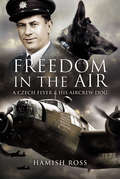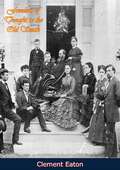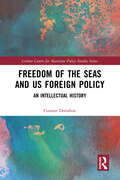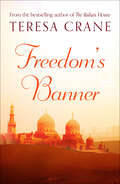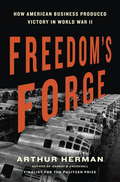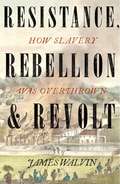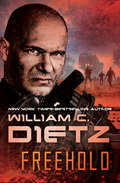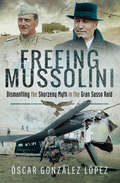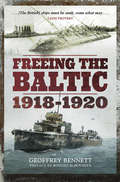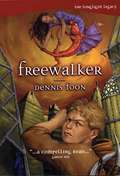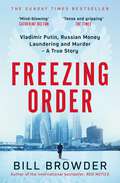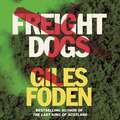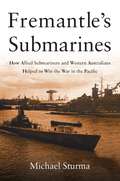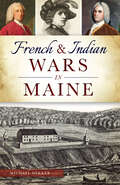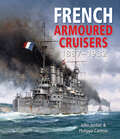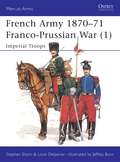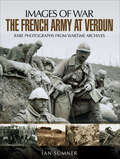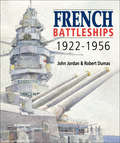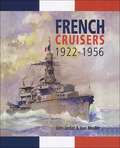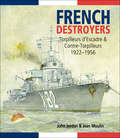- Table View
- List View
Freedom in the Air: A Czech Flyer and his Aircrew Dog
by Hamish Ross&“Deals with a little-known aspect of the war . . . alongside the moving story of one man&’s relationship with a very special animal.&”—Sqn Ldr Paul Scott, Spirit of the Air This biography tells of the life of Václav Robert Bozděch, a Czech airman who escaped from the Nazi invasion, fought with the French and finally arrived in Britain to fly as an air-gunner with the RAF during World War II. He returned to his homeland after World War II but escaped back to the UK again when the communists gained control. Again he joined the RAF and rose to the rank of Warrant Officer. The unique part of this is that from his time in France, throughout World War II and until halfway through his second tour with the RAF, Bozděch was inseparable from his Alsatian dog, Antis, who became famous and was awarded a dog equivalent to the VC. Antis flew with his owner on many bomber raids, became the squadron mascot and was officially a serving RAF dog. He played an amazing part in the second escape from the Czech communist regime, when Bozděch was lucky to make it over the border to the US zone in Germany. &“The main hero of the book is not Bozděch himself, but his Alsatian, Antis . . . This book makes clear the extent of wartime and post-war suffering endured by Czechs and others fulfilling their roles in the overall search for freedom.&”—Aircraft Owner & Pilot &“This absorbing account of flying in WWII is based on the inseparable bond between man and dog. It is a moving story with humor and sadness. A Great Read that is Highly Recommended.&”—Firetrench
Freedom of Thought in the Old South
by Clement EatonFREEDOM of thought and speech in the pre-war South is, as Professor Arthur M. Schlesinger observed during an address at Durham, North Carolina, on April 5, 1939, both a timely and a timeless subject. No event in the modern world is more ominous than the destruction of government by discussion and the repression of independent thought in large areas of Europe by dictatorships. Such ruthless disregard of the rights of minorities of both Fascist and Communist governments serves to remind us that the preservation of free speech and of tolerance is a perennial problem, an ideal to be worked for, never completely attained in any society, and always in danger of being lost in every age. This study of the cultural history of the South between 1790 and 1860, in which freedom of thought and speech is the central theme, is offered as a case history in the record of human liberty and intolerance.“From Jefferson to Calhoun” might well be added as the subtitle of this study. Between the death of Jefferson on July 4, 1826, and the last prophetic speech of Calhoun, March 4, 1850, a great change took place in the Southern States. The liberal ideas of the eighteenth century were in large part discarded, as the queues, the tight breeches, and silk stockings were outmoded. The eighteenth-century cosmopolitanism of the Tidewater gave way to an intensely local point of view. In place of the appeal to reason the suppression of radical criticism was substituted. The sentiment favorable to the emancipation of the slaves held by the most enlightened leaders was not felt by the representative men of a succeeding generation. The skepticism and religious tolerance of the early Republic were erased by waves of evangelism. To explain the causes for, this reversal—the breakdown of the splendid traditions of the eighteenth-century aristocracy—forms the central problem in the social and intellectual history of the South.
Freedom of the Seas and US Foreign Policy: An Intellectual History (Corbett Centre for Maritime Policy Studies Series)
by Connor DonahueThis book critically analyzes US political-military strategy by arguing that freedom of the seas discourse is fundamentally unfit for an era of maritime great power competition.The work conducts a genealogical intellectual history of freedom of the seas discourse in US foreign policy to show how the concept has evolved over time to facilitate American control over the global ocean space. It concludes that the contemporary discourse works to establish the high seas as an arena free from claims of sovereignty so that the United States, as the presumed unrivaled naval power, can intervene globally on behalf of its national interests. However, since sea control strategies depend on a preponderance of material force, as the United States wanes in relative material capability it becomes less able to support political-military strategies predicated on the assumption of global naval dominance. The book provides a timely commentary on the current geopolitical competition between the United States and China, and critiques the US approach toward China in the maritime domain in order to highlight potential avenues of foreign policy action that may enable the two countries to mitigate the risk of conflict.This book will be of much interest to students of naval history, maritime security, US foreign policy, and international relations.
Freedom to Serve: Truman, Civil Rights, and Executive Order 9981 (Critical Moments in American History)
by Jon E. TaylorOn the eve of America’s entry into World War II, African American leaders pushed for inclusion in the war effort and, after the war, they mounted a concerted effort to integrate the armed services. Harry S. Truman’s decision to issue Executive Order 9981 in 1948, which resulted in the integration of the armed forces, was an important event in twentieth century American history. In Freedom to Serve, Jon E. Taylor gives an account of the presidential order as an event which forever changed the U.S. armed forces, and set a political precedent for the burgeoning civil rights movement. Including press releases, newspaper articles, presidential speeches, and biographical sidebars, Freedom to Serve introduces students to an under-examined event while illuminating the period in a new way. For additional documents, images, and resources please visit the Freedom to Serve companion website at www.routledge.com/cw/criticalmoments
Freedom's Banner
by Teresa Crane19th Century Britain: the abolitionists have won. Slavery is outlawed. A valiant victory - but it’s all too easy to forget that in the rest of the world the inhuman practice is still a part of everyday life. A thought that the usually clear-thinking Mattie Henderson chooses to suppress when she finds herself unexpectedly married and on her way to South Carolina with her new husband.Mattie realises too late that she is heading towards a country where a bitter civil war is about to break out - brother against brother, father against son. And the innocent, as always, will suffer with the guilty.A generation later and the battle is still not won: the grim slave trade still flourishes. This time it is Mattie's estranged and headstrong son Harry who, against the backdrop of the glorious River Nile finds himself caught up in the murderous machinations of the slavers.From the American civil war to the slave trade in Egypt, Freedom’s Banner is the perfect generational saga of love, family and redemption for fans of Josephine Cox, Lily Graham and Natasha Lester.
Freedom's Forge: How American Business Produced Victory in World War II
by Arthur HermanNEW YORK TIMES BESTSELLER * SELECTED BY THE ECONOMIST AS ONE OF THE BEST BOOKS OF THE YEARRemarkable as it may seem today, there once was a time when the president of the United States could pick up the phone and ask the president of General Motors to resign his position and take the reins of a great national enterprise. And the CEO would oblige, no questions asked, because it was his patriotic duty. In Freedom's Forge, bestselling author Arthur Herman takes us back to that time, revealing how two extraordinary American businessmen--automobile magnate William Knudsen and shipbuilder Henry J. Kaiser--helped corral, cajole, and inspire business leaders across the country to mobilize the "arsenal of democracy" that propelled the Allies to victory in World War II. "Knudsen? I want to see you in Washington. I want you to work on some production matters." With those words, President Franklin D. Roosevelt enlisted "Big Bill" Knudsen, a Danish immigrant who had risen through the ranks of the auto industry to become president of General Motors, to drop his plans for market domination and join the U.S. Army. Commissioned a lieutenant general, Knudsen assembled a crack team of industrial innovators, persuading them one by one to leave their lucrative private sector positions and join him in Washington, D.C. Dubbed the "dollar-a-year men," these dedicated patriots quickly took charge of America's moribund war production effort. Henry J. Kaiser was a maverick California industrialist famed for his innovative business techniques and his can-do management style. He, too, joined the cause. His Liberty ships became World War II icons--and the Kaiser name became so admired that FDR briefly considered making him his vice president in 1944. Together, Knudsen and Kaiser created a wartime production behemoth. Drafting top talent from companies like Chrysler, Republic Steel, Boeing, Lockheed, GE, and Frigidaire, they turned auto plants into aircraft factories and civilian assembly lines into fountains of munitions, giving Americans fighting in Europe and Asia the tools they needed to defeat the Axis. In four short years they transformed America's army from a hollow shell into a truly global force, laying the foundations for a new industrial America--and for the country's rise as an economic as well as military superpower. Featuring behind-the-scenes portraits of FDR, George Marshall, Henry Stimson, Harry Hopkins, Jimmy Doolittle, and Curtis LeMay, as well as scores of largely forgotten heroes and heroines of the wartime industrial effort, Freedom's Forge is the American story writ large. It vividly re-creates American industry's finest hour, when the nation's business elites put aside their pursuit of profits and set about saving the world.Praise for Freedom's Forge "A rambunctious book that is itself alive with the animal spirits of the marketplace."--The Wall Street Journal "A rarely told industrial saga, rich with particulars of the growing pains and eventual triumphs of American industry . . . Arthur Herman has set out to right an injustice: the loss, down history's memory hole, of the epic achievements of American business in helping the United States and its allies win World War II."--The New York Times Book Review "Magnificent . . . It's not often that a historian comes up with a fresh approach to an absolutely critical element of the Allied victory in World War II, but Pulitzer finalist Herman . . . has done just that."--Kirkus Reviews (starred review)From the Hardcover edition.
Freedom: The Overthrow of the Slave Empires
by Professor James WalvinThis long overdue, vivid and wide-ranging examination of the significance of the resistance of the enslaved themselves - from sabotage and running away to outright violent rebellion - shines fresh light on the end of slavery in the Atlantic World. It is high time that this resistance, in addition to abolitionism and other factors, was given its due weight in seeking to understand the overthrow of slavery. Fundamentally, as Walvin shows so clearly, it was the implacable hatred of the enslaved for slavery and their strategies of resistance that made the whole system unsustainable and, ultimately, brought about its downfall. Walvin's approach is original, too, in looking at the Atlantic world as a whole, including the French and Spanish Empires and Brazil, as well as Britain's colonies. In doing so, he casts new light on one of the major shifts in Western history: in the three-hundred years following Columbus's landfall in the Americas, slavery had become a widespread and critical institution. It had seen twelve million Africans forced onto slave ships; a forced migration that had had seismic consequences for Africa. It had transformed the Americas and materially enriched the Western world. It had also been largely unquestioned - in Europe at least, and among slave owners, traders and those who profited from the system. Yet, within a mere seventy-five years during the nineteenth century, slavery had vanished from the Americas: it had declined, collapsed and been destroyed by a complexity of forces that, to this day, remains disputed. As Walvin shows so clearly here, though, it was in large part overthrown by those it had enslaved.
Freehold
by William C. DietzA band of mercenaries faces off with invading aliens in this novel by the New York Times–bestselling author of the America Rising series. Colonel Stell and his band of mercenaries yearn for a place to call home. To them Freehold is like a bright diamond in the vast universe. But its desert conditions, economic instability, social disarray, and political turmoil render the planet perfect for takeover. Willing to fight anything that stands in their way, Colonel Stell and his small crew contend with all who seek to dominate their planet, even vast interstellar empires. Their success will not be determined by their size but by their resolution to create a home for themselves.
Freeing Mussolini: Dismantling the Skorzeny Myth in the Gran Sasso Raid
by Óscar González LópezThe untold inside story of the audacious Nazi plot to rescue il Duce from an Allied prison. The operation to free Mussolini, who was being held prisoner in a high mountain hotel on the summit of Gran Sasso, Italy, in September 1943, is without a doubt one of the most spectacular operations not only of the Second World War, but in all military history. German paratroopers, the Wehrmacht’s elite, were responsible for organizing the rescue in record time, and executing a daring and perfectly synchronized operation between land and airborne detachments. Surprise and speed were the Fallschirmjäger’s main weapons, surprising the Italian garrison guarding il Duce. For political reasons Otto Skorzeny, the clever SS officer, also participated in the operation, leading a dozen of his commandos. Propaganda and his connections with Himmler made him into the false hero of the mission, over-emphasizing his role in the whole search and rescue operation. Based on the testimony of several protagonists in this incredible operation, as well as analyzing major documents (letters, reports by General Kurt Student, etc.) and the abundant literature available on the subject, this book dismantles the “Skorzeny Myth” and reveals the truth of what really happened in a mission that even Churchill called “one of great daring.”
Freeing the Baltic, 1918–1920
by Geoffrey BennettIn 1919, the new governments of the besieged Baltic states appealed desperately to the Allies for assistance. A small British flotilla of light cruisers and destroyers were sent to help, under the command of Rear Admiral Sir Walter Cowan. They were given no clear instructions as to what their objective was to be and so Cowan decided that he had to make his own policy. Despite facing a much greater force, Cowan improvised one of the most daring raids ever staged by the British Navy. He succeeded with devastating effect; outmaneuvering his enemies, sinking two Russian Battleships and eventually freeing the Baltic states of Estonia, Latvia and Lithuania.
Freewalker (The Longlight Legacy #2)
by Dennis FoonIn this highly suspenseful novel in The Longlight Legacy, one year has passed since Roan, Alandra and the children escaped from the Brothers. Now, in the haven they call New light, Alandra has begun traveling the Dreamfield with the children.
Freezing Order: A True Story of Russian Money Laundering, State-Sponsored Murder,and Surviving Vladimir Putin's Wrath
by Bill Browder&‘More explosive, compulsive and gasp-inducingly, spine-tinglingly, mouth-dryingly, heart-poundingly thrilling than any fiction I have read for years, but it is all true' Stephen Fry'Mind-blowing...Browder's battle for justice is at times terrifying, at times deeply touching' Catherine Belton&‘A jaw-dropping exposé by Putin&’s anti-corruption nemesis&’ Daily TelegraphFollowing his explosive international bestseller Red Notice, Bill Browder returns with another gripping thriller chronicling how he became Vladimir Putin&’s number one enemy by exposing Putin&’s campaign to steal and launder hundreds of billions of dollars and kill anyone who stands in his way.When Bill Browder&’s young Russian lawyer, Sergei Magnitsky, was beaten to death in a Moscow jail, Browder made it his life&’s mission to go after his killers and make sure they faced justice. The first step of that mission was to uncover who was behind the $230 million tax refund scheme that Magnitsky was killed over. As Browder and his team tracked the money as it flowed out of Russia through the Baltics and Cyprus and on to Western Europe and the Americas, they were shocked to discovered that Vladimir Putin himself was a beneficiary of the crime.As law enforcement agencies began freezing the money, Putin retaliated. He and his cronies set up honey traps, hired process servers to chase Browder through cities, murdered more of his Russian allies, and enlisted some of the top lawyers and politicians in America to bring him down. Putin will stop at nothing to protect his money. As Freezing Order reveals, it was Browder&’s campaign to expose Putin&’s corruption that prompted Russia&’s intervention in the 2016 US presidential election.At once a financial caper, an international adventure and a passionate plea for justice, Freezing Order is a timely and stirring morality tale about how one man can take on one of the most ruthless villains in the world.
Freight Dogs
by Giles Foden1996: in a Ugandan dive bar, the 'freight dogs' gather. An anarchic group of mercenary pilots from Texas, Russia, Kenya and Belgium who transport weapons between warring African nations, without allegiance. And tonight they have a new recruit - Manu, a 19-year-old cowherd fleeing Congo's bloody war.Taken in by this band of unlikely brothers, he's soon seeing his vast country from above and falling in love with flying. But no matter how fast he flies, trouble follows closely behind. And when the past erupts back into this new life, Manu is forced to leave behind African skies for the chilly embrace of northern Europe. Will Manu be able to reinvent himself yet again? And is Belgian volcanologist Anke Desseaux the answer to his problems - or simply another one of them?From the writer of The Last King of Scotland comes an unforgettable story of survival - about how to live and love after trauma, set against a backdrop of world-shaking conflict.
Freight Dogs (W&N Essentials)
by Giles Foden1996: in a Ugandan dive bar, the 'freight dogs' gather. An anarchic group of mercenary pilots from Texas, Russia, Kenya and Belgium who transport weapons between warring African nations, without allegiance. And tonight they have a new recruit - Manu, a 19-year-old cowherd fleeing Congo's bloody war.Taken in by this band of unlikely brothers, he's soon seeing his vast country from above and falling in love with flying. But no matter how fast he flies, trouble follows closely behind. And when the past erupts back into this new life, Manu is forced to leave behind African skies for the chilly embrace of northern Europe. Will Manu be able to reinvent himself yet again? And is Belgian volcanologist Anke Desseaux the answer to his problems - or simply another one of them?From the writer of The Last King of Scotland comes an unforgettable story of survival - about how to live and love after trauma, set against a backdrop of world-shaking conflict.
Fremantle's Submarines
by Michael SturmaFrom unpromising beginnings in March 1942, the submarine base at Fremantle became a vital part of the Allied offensive against Japan. Pushed back from the Philippines and the Netherlands East Indies, American submariners, accompanied by small numbers of Dutch, retreated to Fremantle on the remote west coast of Australia as a port of last resort. Far from their prospective patrol areas and their own supply lines, they had little reason to feel optimistic. Thanks largely to a welcoming civilian population, the morale of Allied submariners quickly improved, as did their effectiveness in fighting the enemy. The first arrival of American and Dutch submarines at Fremantle coincided with a period when Western Australians felt especially vulnerable. On 3 March Japanese Zero fighters bombed the towns of Wyndham and Broome, while the same day there were three Japanese submarine attacks on shipping off the Western Australian coast. With many locals convinced that a Japanese invasion was imminent, Allied submariners got an appreciative reception. While in relatively small numbers, submariners were widely perceived as an elite force not only within the navy, but more generally by those who admired their courage and commitment. Although the Australians had no submariners of their own, they supported the base through the mobilization of resources and labor. Joined by British submariners from 1944, Allied submarines made a total of 416 patrols from Fremantle during the course of the war, becoming the most active base in the Pacific after Pearl Harbor. Some of the most famous submarines of the Second World War - including USS Harder, USS Flasher and HMS Trenchant - operated out of Fremantle, and many of the submariners who sailed from that port made the ultimate sacrifice. The success of Fremantle’s submarines depended not only on personal heroism, but cooperation between allies. From disastrous beginnings, the Allies overcame inertia and national suspicions to become a much more effective fighting force than their enemies. The Australian government provided unstinting support, while Australian commandos shared the perils of many submarine patrols. Meanwhile cooperation between American, Dutch and British submariners pioneered joint naval operations in the Pacific. This book documents not only the courage of submarine crews and the multinational cooperation that developed between Allies, but integrates the experiences of submariners on shore with their operations at sea. The promise of leave in Australia made the hardships and perils of lengthy war patrols more bearable. News that a submarine was ending its patrol in Fremantle inevitably created an expectant excitement among the crew on board. The hospitality and sense of belonging fostered by Western Australians became legendary among Allied submariners and remains central to their wartime memories. Many of those memories focus on relationships with young women, frequently sealed permanently through marriages. Many submariners also remember fondly the high alcohol content of Australian beer. Most of all, however, they recall the generosity of those civilians who welcomed them into their homes and hearts. At the same time, visiting submariners helped fill the emotional void created in many Australian families by absent sons, brothers, fathers and husbands fighting overseas. In an atmosphere of wartime austerity and rationing, the submariners also proved generous in sharing scarce resources with the local population. From the standpoint of morale, Fremantle became one of the most successful military outposts of the Second World War.
French & Indian Wars in Maine (Military Ser.)
by Michael DekkerCovering nearly a century of conflict, this history chronicles the tragic, epic struggle for the land that would become Maine. For eight decades, a power struggle raged across a frontier on the north Atlantic coast now known as the state of Maine. Between 1675 and 1759, British, French, and Native Americans soldiers clashed in six distinct wars to claim the strategically vital region. In French and Indian Wars in Maine, historian Michael Dekker sheds light on this dark, tragic and largely forgotten struggle that laid the foundation of Maine. Though the showdown between France and Great Britain was international in scale, the local conflicts in Maine pitted European settlers against Native American tribes. Native and European communities from the Penobscot to the Piscataqua Rivers suffered brutal attacks. Countless men, women and children were killed, taken captive or sold into servitude. The native people of Maine were torn asunder by disease, social disintegration and political factionalism as they fought to maintain their autonomy in the face of unrelenting European pressure.
French Armoured Cruisers, 1887–1932: 1887-1932
by John Jordan Philippe Caresse“Offers a fascinating look at the French Navy during the years leading up to World War I . . . an excellent addition to any naval library.” —Naval Historical FoundationOf all the threats faced by the Royal Navy during the first years of the twentieth century, the one which stood out was the risk to Britain’s sea lines of communication posed by France’s armoured cruisers. Fast, well-armed and well-protected, these ships could have evaded any attempted blockade of the French ports and, supported by a worldwide network of overseas bases, could potentially have caused havoc on the trade routes. Between 1898 and 1901 the French laid down thirteen ships, and completed nine in 1903–4 alone.This book has as its subject the French armoured cruisers built from the late 1880s until shortly before the outbreak of the Great War, beginning with the revolutionary Dupuy-de-Lôme, the world’s first modern armoured cruiser, and ending with the impressive six-funnelled Edgar Quinet and Waldeck-Rousseau. The primary focus of the book is on the technical characteristics of the ships. Detailed and labelled drawings based on the official plans are provided by John Jordan, and each individual class of ship is illustrated by photographs from the extensive personal collection of Philippe Caresse. The technical section is followed by a history in two parts, covering the Great War (1914–18) and the postwar years, during which the surviving ships saw extensive deployment as “station” cruisers overseas and as training ships. This is the most comprehensive account published in English or in French, and is destined be the standard reference for many years to come.“Brilliant, absolutely brilliant.” —War History Online
French Army 1870-71 Franco-Prussian War
by Jeffrey Burn Stephen ShannAt the time of the Second Empire, under Napoleon III, the French army, elevated from tactful obscurity, was re-modelled on Napoleonic lines. This army first fought in the Crimea, and then against Austria. Later, In Mexico, they had a disastrous adventure while in Europe Prussia was fast emerging as a challenge to France's military pre-eminence. Together with Austria, Bismarck first crushed Denmark before turning on Austria herself. The victory at Sadowa in 1866 stunned Europe, and in Paris Napoleon and his advisers set to thinking of a way to counter this new threat. In this first of two volumes looking at the French Army of the Franco-Prussian War, Stephen Shann and Louis Delperier examine the history, organisation and weapons of the French Imperial troops.
French Army 1870-71 Franco-Prussian War
by Richard Hook Stephen ShannThe capitulation of Napoleon and his army at Sedan in September 1870 shook Paris to its foundations. The Second Empire was swept from power, and a Government of National Defence hastily put in its place. To replace the weakened professional army the French called for a 'war of the people'. A companion volume to Men-at-Arms 233: The French Army 1870-71 Franco-Prussian War (1) Imperial Troops, this book covers the forces that participated in the second half of the campaign, including the regular army, l' Armeé d' Afrique, la Garde Mobile, la Garde Nationale and the naval forces. The text is accompanied by contemporary photographs and detailed colour plates.
French Army at Verdun: Rare Photographs From Wartime Archives (Images Of War Bks.)
by Ian SumnerIn four and a half years of fighting on the Western Front during the First World War a few battles stand out from the rest. They had a decisive impact on the course of the conflict, and they still define the war for us today. For the French, the Battle of Verdun, fought between February and December 1916, was one of the greatest of these. That is why the selection of contemporary photographs Ian Sumner has brought together for this volume in the Images of War series is so important and revealing. They show the strained, sometimes shocked faces of the soldiers, record the shattered landscape in which they fought, and give us an insight into the sheer intensity of the fighting.At the time, and ever since, the battle has been portrayed as a triumph of French tenacity and heroism that is encapsulated in the famous phrase They shall not pass. These photographs remind us, in the most graphic way, what that slogan meant in terms of the devastating personal experience of the men on the Verdun battlefield.
French Battleships, 1922–1956
by John Jordan Robert DumasThis illustrated naval history presents a comprehensive study of French battleships constructed after the Washington Naval Treaty of 1922. The French battleships of the Dunkerque and Richelieu classes were the most radical and influential battleship designs of the interwar period, and were coveted by the British, German and Italian navies following the Armistice of June 1940. Using a wealth of primary-source material, this volume provides a full account of their development and a detailed analysis of their design characteristics. The technical chapters are interspersed with operational histories, with a particular focus on the operations in which the ships engaged other heavy units. The book is extensively illustrated with hundreds of photographs and technical drawings, including twenty-two color profile and plan views of the ships. An introductory chapter provides additional historical context with an overview of French naval craft from the Dreadnaught era through the First World War.
French Colonial Soldiers in German Captivity during World War II
by Raffael ScheckThis book discusses the experience of nearly 100,000 French colonial prisoners of war captured by Nazi Germany during World War II. Raffael Scheck shows that the German treatment of French colonial soldiers improved dramatically after initial abuses, leading the French authorities in 1945 to believe that there was a possible German plot to instigate a rebellion in the French empire. Scheck illustrates that the colonial prisoners' contradictory experiences with French authorities, French civilians, and German guards created strong demands for equal rights at the end of the war, leading to clashes with a colonial administration eager to reintegrate them into a discriminatory routine.
French Cruisers, 1922–1956: 1922-1956
by John Jordan Jean MoulinA technical analysis and pictorial history of the French navy cruisers built in the early to mid-twentieth century. The French produced some of the most striking and innovatory interwar cruiser designs. A large amount of new information about these ships has become available over the past twenty years in France, but this book is the first to make this accessible to an English-speaking readership. Part I explains the design philosophy behind each of the classes built after 1922, and outlines the characteristics of each type, accompanied by detailed data tables and a comprehensive set of specially-drawn plans based on official documents, as well as carefully-selected photographs. Coverage includes the De Grasse, laid down in August 1939 and completed postwar as an AA cruiser, and also the heavy cruisers of the Saint Louis class intended to follow her, about which little has been published. Part II deals with the historical side, covering not only the eventful careers of these ships, but also explaining the peacetime organization of the Marine Nationale, the complex politics of this turbulent period and their impact on the navy. Like its highly successful predecessor, French Battleships, this beautifully presented book subtly blends technical and historical analysis to produce what must become the standard reference work.Praise for French Cruisers&“A clearly-written and excellently presented book which, particularly with respect to its technical descriptions, explains its chosen subject area in a convincing and comprehensive fashion. The authors are to be commended for their achievement in bringing knowledge of a previously sparsely-covered subject to an English language readership.&” —Warship Annual 2014
French Defence Policy Since the End of the Cold War (Cass Military Studies)
by Olivier Schmitt Alice PannierThis book describes the evolution of French defence policy since the end of the Cold War. For the past thirty years there have been significant changes to French defence policy as a result of several contextual evolutions. Changes include shifts in the global balance of power, new understandings of the notion of international security, economic downturns, and developments in European integration. Yet despite these changes, the purpose of France’s grand strategy and its main principles have remained remarkably stable over time. This book identifies the incentives, representations and objectives of French defence policy The authors examine the general mechanisms that influence policy change and military transformation in democracies, the importance of status-seeking in international relations, the processes of strategy-making by a middle power, and the dilemmas and challenges of security cooperation. By doing so the book raises a number of questions related to the ways states adjust (or not) their security policies in a transformed international system. This book makes French-language sources available to non-French-speaking readers and contributes to a better understanding of a country that is at the forefront of Europe’s external action. This book will be of great interest to students of defence studies, French politics, military studies, security studies, and IR in general.
French Destroyers: Torpilleurs d'Escadre & Contre-Torpilleurs, 1922–1956
by John Jordan Jean Moulin&“A superb book that will keep any reader happy for months as they discover stories and episodes in French naval destroyer design and history.&”—Warship World Between the wars the French produced some of the largest, and certainly the fastest, destroyers in the world. Known as Contre-Torpilleurs, these striking and innovatory super-destroyers form the core of this book, but the more conventional Torpilleurs d&’Escadre are also covered. This history combines the technical and service material published in French-language monographs over the past two decades with the authors&’ own research from primary sources. The structure of the book follows that of the highly successful French Cruisers, with Part I devoted to the design of each of the classes built after 1922. The text is accompanied by detailed data tables and illustrated by a comprehensive set of specially drawn plans and schemas based on official documents, as well as carefully selected photographs from French naval sources and from private collections. Coverage runs down to the Le Hardi class, the last pre-war design. Part II deals with the historical side, covering the eventful careers of these ships before, during and after the war. This section is illustrated by maps specially drawn for the book, and by contemporary photographs. Like its highly successful predecessors, French Battleships and French Cruisers, this beautifully presented book &“fills a significant gap in the English library about French warships. Apart from that the book will absolutely be a treasure on the bookshelves of collectors, historians, ships modelers and all other devotees of maritime history&” (Go2War2.nl).
